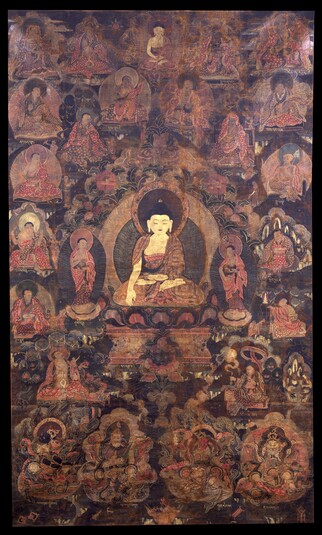
Item: Shakyamuni Buddha - with Sixteen Elders (Arhats)
| Origin Location | China |
|---|---|
| Date Range | 1700 - 1799 |
| Lineages | Gelug and Buddhist |
| Material | Ground Mineral Pigment on Cotton |
| Collection | Tibet House, New York |
Classification: Person
Appearance: Buddha
Gender: Male
Shakyamuni Buddha (Tibetan: sha kya thu pa, sang gye, English: the Enlightened One, Sage of the Shakya Clan) together with the foremost students Shariputra and Maudgalyayana, the 16 Arhats, Dharmata, Hvashang and the worldly Kings of the Four Directions.
Sanskrit: Buddha Shakyamuni Tibetan: Sang gye sha kya tu pa
Tibetan: Sang gye sha kya tu pa
Golden in colour, formal in posture, his black hair is piled in a topknot (Sanskrit: ushnisha) crowned with a small gold ornament at the peak. The right hand extended across the knee is in the mudra (gesture) of earth witness. The left hand in the mudra of meditation is placed palm upward in the lap. Wearing dark orange robes, with the two feet crossed in vajra posture, atop a multi-coloured lotus seat, he sits above a snow lion supported throne surrounded by a nimbus of green and yellow light and an areola of dark blue. Various flower blossoms and green foliage forms a thick canopy above.
Standing at the side is Shariputra on the left and Maudgalyayana on the right. Both hold a mendicant staff in the right hand and a black begging bowl in the left. Wearing robes orange in colour, the head framed by an orange areola, they stand on moon disc and lotus seats.
At the top center is the Buddha of Boundless Light, Amitabha, with the two hands folded in the mudra of meditation in the lap. Descending from the top left are 8 of the 16 Arhats. [1] Angaja holding a fly whisk and an incense bowl. [2] Ajita with the head covered and the hands clasped around the upright knees. [3] Kalika holding a pair of gold earrings. [4] Vanavasin holding a flywhisk and the left hand in the gesture of meditation. [5] Vajriputra holding a flywhisk. [6] Bhadra performs the mudras of explication and meditation. [7] Kanakavatsa holds a jewelled lasso. [8] Kanaka Bharadhvaja has both hands in meditation.
Descending from the left are [9] Rahula holding a jewelled tiara with both hands. [10] Bakula holds a mongoose. [11] Pindola Bharadhvaja holds a book and begging bowl. [12] Chudapantaka has both hands in meditation. [13] Pantaka holds a book. [14] Nagasena holds a vase and staff. [15] Gopaka holds a book. [16] Abheda holds a stupa. Each is attired in various robes and seated in a variety of postures.
Seated below the throne at the left side is Hvashang, the patron to the arhats, sent by the Chinese Emperor to invite the Buddha Shakyamuni to the imperial court. He holds a mala of prayer beads in the right hand and a persimmon fruit in the left; surrounded by playful children. At the right side is the layman Dharmata, chief attendant to the arhats. In the right hand a water flask is held with rising vapors forming the appearance of the Buddha Amitabha hovering in the sky in front. A load of books stacked in a carrying case sits at the side and a large canopy rises above the head of Dharmata.
At the bottom are the Kings of the Four Directions, from the left, Virudhaka, blue in colour, holding a sword and Dhritarashtra, pink, holding a lute. Followed by Virupaksha, red, holding a stupa and a snake lasso, and lastly the leader, Vaishravana, yellow, holding a victory banner and a mongoose. Decked in the raiment of warriors with ornate headdresses and the like, they sit in relaxed postures surrounded by swirling smoke.
The Lord Atisha (982-1054) and Kashmiri pandita Shakya Shribhadra (1127-1225) popularized the ritual service and offerings to the Buddha Shakyamuni and 16 Arhats.
Jeff Watt 8-99
Collection of Tibet House: New York (Repatriation)
Shakyamuni Buddha with 16 Arhats
Shakyamuni Buddha & the Sixteen Elders (Single Composition)
